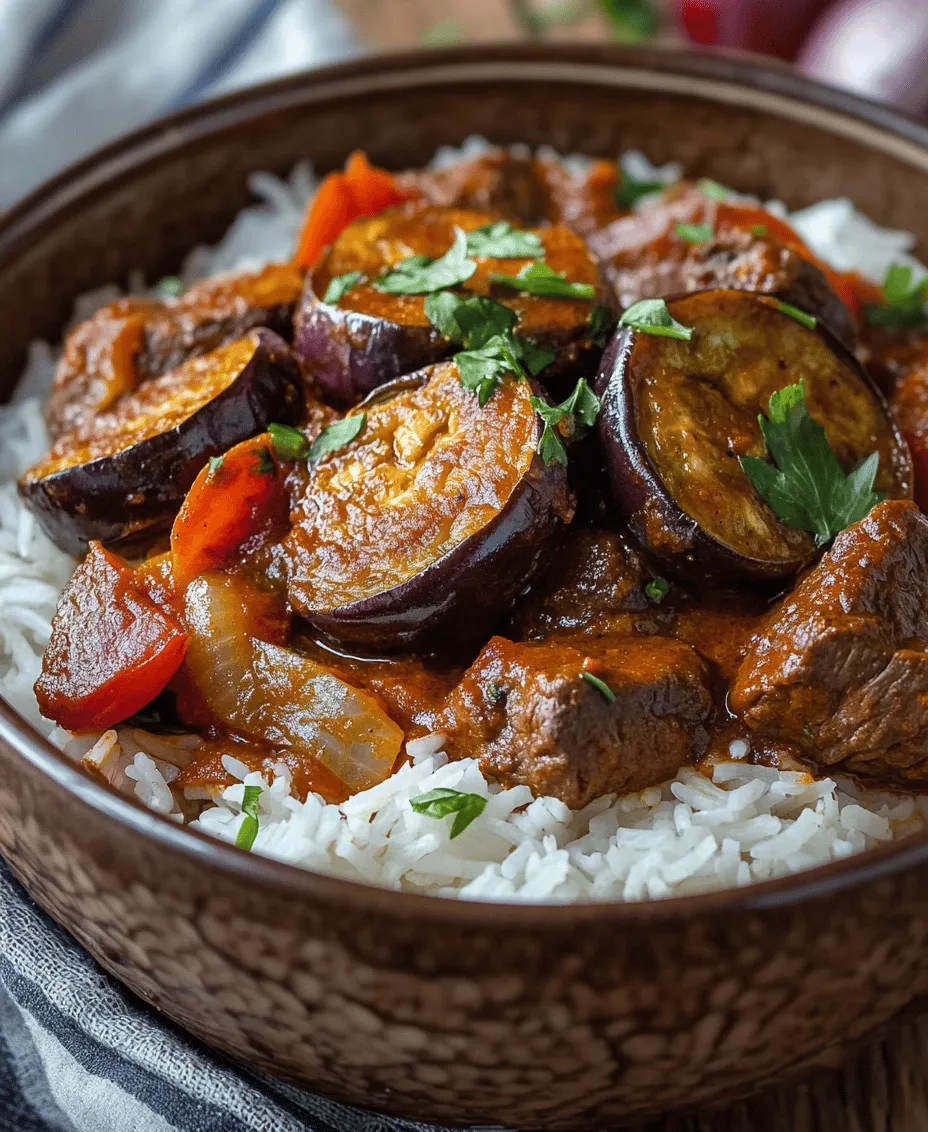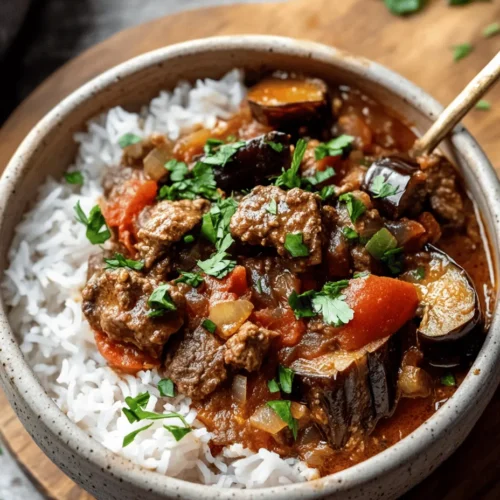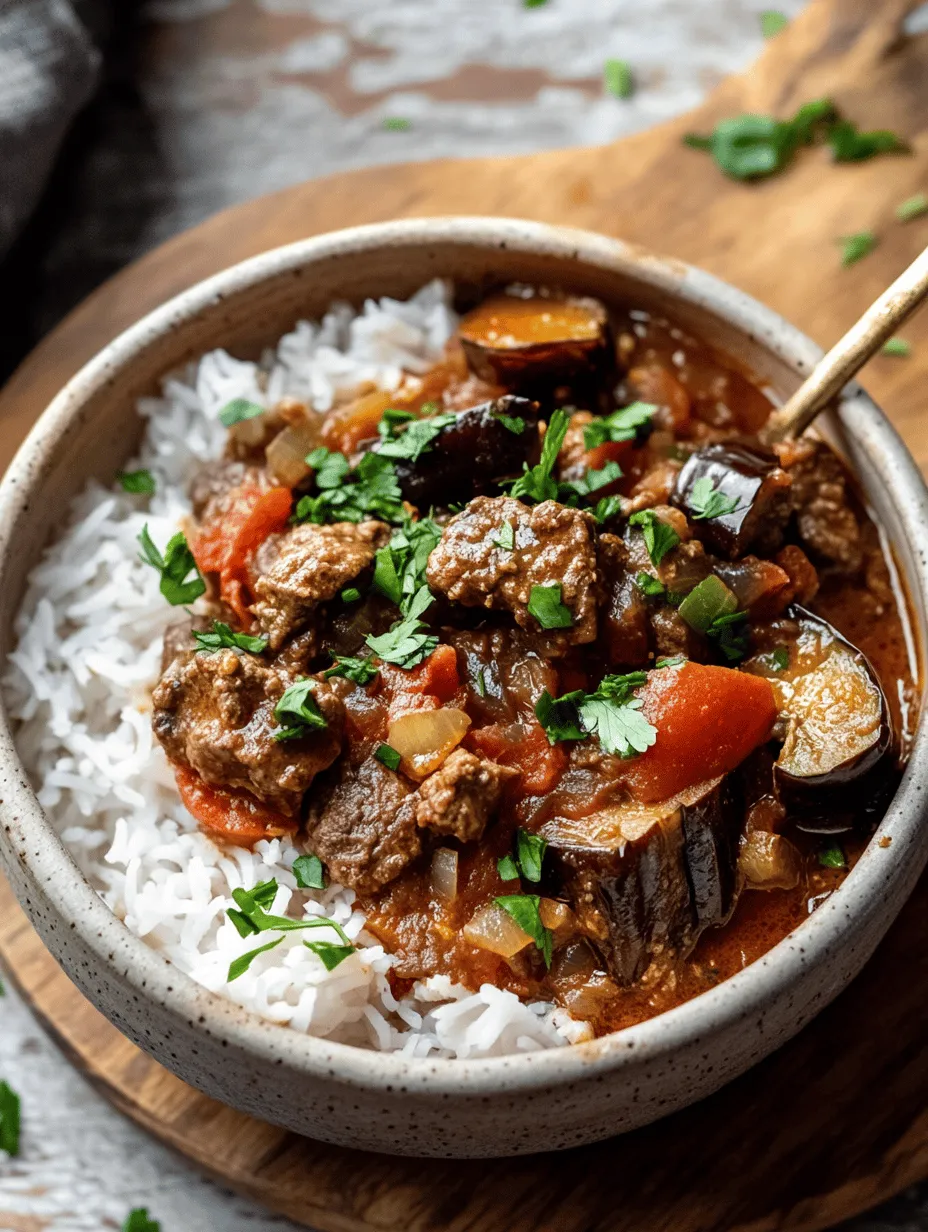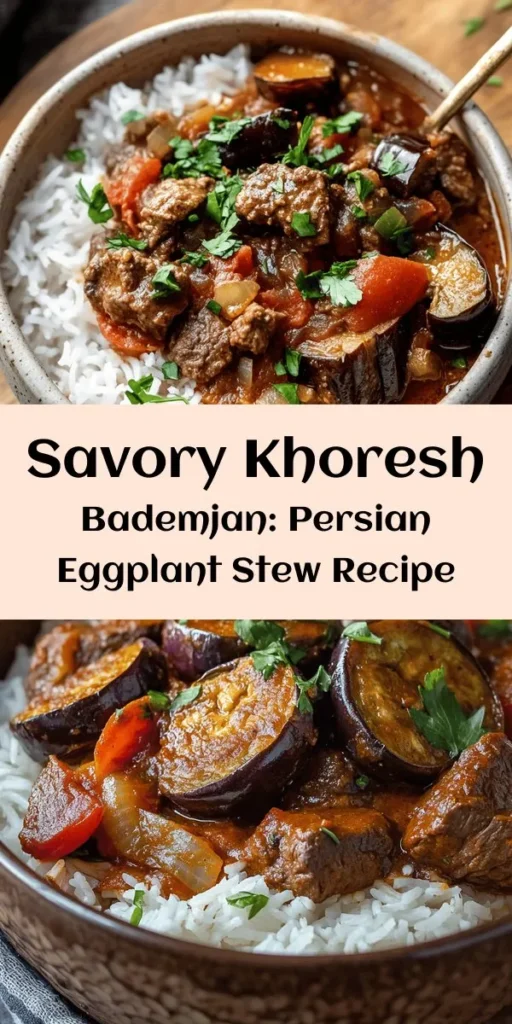Introduction
Khoresh Bademjan is more than just a dish; it’s a culinary experience that encapsulates the rich tapestry of Persian cuisine. This traditional Persian eggplant stew, recognized for its deep flavors and comforting textures, features tender pieces of meat simmered alongside a medley of spices and, of course, the star ingredient: eggplant. As a staple in many Iranian households, Khoresh Bademjan is not only a meal but a celebration of family, culture, and the vibrant history of Iranian gastronomy.
In this article, we will delve into the intriguing origins of Khoresh Bademjan, discussing its cultural significance and the variations that exist across different regions. Additionally, we will provide a comprehensive guide to making this delightful dish, complete with detailed instructions and serving suggestions. Prepare your taste buds for a flavorful journey that brings the essence of Persian cooking right into your kitchen.
Understanding Khoresh Bademjan
The Essence of Khoresh: A Look into Persian Stews
Khoresh, which translates to “stew” in Persian, is a fundamental element of Iranian cuisine. Traditionally served over rice, khoresh dishes are characterized by their slow-cooked nature, allowing the ingredients to meld together harmoniously. This method of cooking not only enhances the flavors but also creates a comforting and hearty meal that is perfect for any occasion, from everyday dinners to festive gatherings.
Khoresh Bademjan stands out among the various khoresh recipes due to its unique combination of eggplant, meat, and spices. The dish is often served with saffron-infused basmati rice, creating a beautiful contrast of textures and flavors. Each bite offers a taste of the rich culinary heritage that has been passed down through generations.
The Role of Eggplant in Persian Cuisine
Eggplant, known as “bademjan” in Persian, is a beloved ingredient in Iranian cooking. Its versatility allows it to be featured in a variety of dishes, from appetizers to main courses. In Khoresh Bademjan, the eggplant plays a crucial role—not only does it provide depth and substance to the stew, but it also absorbs the aromatic spices and flavors of the meat, resulting in a rich, savory experience.
Beyond its culinary uses, eggplant has also been celebrated in Persian literature and poetry, symbolizing abundance and hospitality. This cultural significance adds another layer of appreciation for khoresh, as it reflects the values of sharing and community that are inherent to Persian dining.
Cultural Significance and Variations of Khoresh Bademjan
Khoresh Bademjan is deeply rooted in Iranian culture, often associated with gatherings and family meals. Each region of Iran has its own take on this classic dish, incorporating local ingredients and cooking methods. For instance, in some areas, a touch of sourness is introduced through the addition of dried limes or pomegranate molasses, while others might opt for a simpler preparation that highlights the natural flavors of the eggplant and meat.
The variations of Khoresh Bademjan also extend to the choice of meat. While beef is commonly used, lamb or even chicken can be substituted, each imparting its own unique flavor profile to the stew. This adaptability makes Khoresh Bademjan a versatile dish that can cater to different tastes and dietary preferences.
Ingredients Overview
Essential Ingredients for Khoresh Bademjan
To create a delicious Khoresh Bademjan, it is vital to gather the right ingredients. Here’s a rundown of what you will need:
– Eggplants: Choose firm, fresh eggplants for the best texture.
– Meat: Opt for either beef or lamb, cut into bite-sized pieces.
– Onions: A couple of medium-sized onions, finely chopped, serve as the aromatic base.
– Tomatoes: Fresh tomatoes or tomato paste add a layer of richness to the stew.
– Spices: A mix of turmeric, cinnamon, and saffron are essential for authentic flavor.
– Salt and Pepper: To taste, enhancing the overall seasoning of the dish.
The Importance of Fresh Ingredients
Using fresh, high-quality ingredients is crucial when preparing Khoresh Bademjan. Fresh eggplants will provide the best texture and flavor, while quality meat will ensure that your stew is hearty and satisfying. When shopping for produce, look for eggplants that are smooth and shiny with a rich purple hue. They should feel heavy for their size, indicating that they are fresh and full of moisture.
Key Spices that Define the Flavor Profile
The spices used in Khoresh Bademjan are what truly elevate the dish, creating a symphony of flavors that are both comforting and exotic.
– Turmeric: This bright yellow spice adds warmth and depth to the stew.
– Cinnamon: A pinch of cinnamon provides a subtle sweetness that balances the savory components.
– Saffron: Known as the “golden spice,” saffron contributes a luxurious aroma and vibrant color.
These spices, when combined, create a fragrant base that infuses the meat and eggplant with rich flavors throughout the cooking process.
Choosing the Right Meat: Beef vs. Lamb
When it comes to choosing the meat for your Khoresh Bademjan, both beef and lamb have their own merits. Beef is often favored for its robust flavor and tenderness, while lamb offers a more delicate taste that pairs beautifully with the spices. If you prefer a richer stew, lamb might be the perfect choice. However, if you are looking for something heartier, beef will deliver that satisfying depth.
Preparation of Eggplants: Salting and Drying
One key step in preparing the eggplant for Khoresh Bademjan is salting and drying it. This technique serves two purposes: it removes excess moisture from the eggplant, preventing it from becoming soggy during cooking, and it reduces any bitterness that may be present.
To prepare the eggplants, slice them into rounds or lengthwise, depending on your preference. Sprinkle a generous amount of salt over the slices and let them sit for about 30 minutes. This process will draw out moisture, which you can then rinse off before frying. Pat the eggplants dry with a paper towel to remove any excess salt and moisture, ensuring they fry up beautifully and retain their shape in the stew.
Step-by-Step Guide to Making Khoresh Bademjan
Preparing the Eggplants: Techniques for Optimal Texture
Once your eggplants are salted and dried, it’s time to fry them. This step is crucial for achieving the perfect texture and flavor. The frying process caramelizes the eggplant, enhancing its natural sweetness and creating a lovely golden exterior.
– Heat a generous amount of oil in a large skillet over medium-high heat.
– Once the oil is hot, carefully add the eggplant slices in batches to avoid overcrowding the pan.
– Fry until they are golden brown on both sides, about 3-4 minutes per side.
– Remove the fried eggplants from the skillet and place them on paper towels to absorb any excess oil.
Frying the eggplants not only adds flavor but also creates a lovely contrast to the tender meat in the stew. This step is essential for achieving the ideal balance of textures in your Khoresh Bademjan.
Frying the Eggplants: Achieving the Perfect Golden Brown
Frying the eggplant until golden brown is a crucial step in the Khoresh Bademjan preparation. The goal is to achieve a soft but slightly crispy exterior that will hold up during the simmering process.
– If needed, adjust the heat as you fry to ensure the eggplants cook evenly without burning.
– It’s important not to skip this step, as it significantly enhances the depth of flavor in the finished dish.
With the eggplants perfectly fried, you are now ready to move forward in the cooking process by combining them with the meat and aromatic spices. This rich and savory stew will soon become a beloved addition to your culinary repertoire, inviting friends and family to gather around the table for a delightful Persian feast.
In the next section of this article, we will detail the remaining steps to complete Khoresh Bademjan, ensuring you have everything you need to create this traditional Persian dish at home. Stay tuned for insights on combining the ingredients, simmering the stew, and serving suggestions that will elevate your dining experience.

Cooking the Meat: Building Flavor from the Base
To create a truly memorable Khoresh Bademjan, the meat is an essential component that adds depth and richness to the dish. Begin by selecting a good quality cut of lamb or beef, as both offer unique flavors that complement the eggplant and spices.
Browning the Meat: Importance in Stew Preparation
Start by heating a generous amount of vegetable oil in a heavy-bottomed pot over medium-high heat. Once the oil is shimmering, carefully add the meat in batches. Avoid overcrowding the pot, as this will lower the temperature and prevent proper browning. Sear the meat for about 5-7 minutes on each side until it develops a beautiful golden crust. This browning process is crucial; it not only enhances the flavor through the Maillard reaction but also contributes to the overall color and texture of the stew. Once browned, remove the meat from the pot and set it aside.
Incorporating Spices and Tomatoes: Creating Depth of Flavor
In the same pot, add finely chopped onions and sauté them until they are translucent and slightly caramelized, about 5 minutes. The sweetness of the onions will build the flavor base. Next, incorporate minced garlic and ginger, cooking for an additional minute until fragrant.
Now it’s time to add your spices to the mix. A combination of turmeric, cinnamon, and black pepper will provide a warm, aromatic profile that is characteristic of Persian cuisine. Stir these spices into the onion mixture, ensuring they are evenly coated. This step is essential, as toasting the spices releases their essential oils, enhancing the dish’s overall flavor.
After the spices have bloomed, add in your diced tomatoes—either fresh or canned work well. Allow the tomatoes to cook down for a few minutes, releasing their juices and amalgamating with the spices and onions to create a rich sauce. Once this mixture has thickened slightly, return the browned meat to the pot, along with the crushed saffron dissolved in a tablespoon of warm water. This not only adds a beautiful golden hue but also infuses the dish with its unique aroma.
Simmering the Stew: The Art of Slow Cooking
Now that all the ingredients are combined, it’s time to let the magic happen. Pour in enough water or broth to cover the meat by about an inch. Bring the mixture to a gentle boil, then reduce the heat to low, cover the pot, and let it simmer. The ideal cooking time for Khoresh Bademjan is about 1.5 to 2 hours. This slow cooking allows the flavors to meld together, and the meat becomes tender and succulent. Stir occasionally and check the liquid level; you want to ensure it doesn’t dry out, adding more water if necessary.
Combining Eggplants with the Stew: Integrating Textures and Flavors
While the stew simmers, it’s time to prepare the eggplants. Slice them into thick rounds and sprinkle with salt. Let them sit for about 30 minutes. This process draws out excess moisture and bitterness from the eggplants. After 30 minutes, rinse the eggplant slices under cold water and pat them dry with a paper towel.
In a separate skillet, heat oil over medium heat and fry the eggplant slices until they are golden brown on both sides. This frying process is crucial as it adds a rich, savory element to the dish. Once fried, set the eggplants aside on a paper towel to absorb any excess oil.
When the meat is tender and the flavors are well-developed, gently fold the fried eggplants into the stew. Be careful not to break them apart; you want to maintain their structure for a pleasing texture in the final dish. Allow the stew to simmer for an additional 20-30 minutes, letting the eggplants absorb the flavors of the sauce.
Final Touches: Adjusting Seasoning and Garnishing
Before serving, taste the Khoresh Bademjan and adjust the seasoning as necessary. Depending on your preference, you might want to add a touch more salt, a hint of sugar to balance the acidity, or even a squeeze of fresh lemon juice for brightness. Once seasoned to perfection, serve the stew hot, garnished with freshly chopped parsley or cilantro for a pop of color and freshness.
Serving Suggestions
The Perfect Accompaniment: Serving with Basmati Rice
Khoresh Bademjan is traditionally served alongside fluffy basmati rice, which acts as the perfect vehicle to soak up the rich stew. To prepare the rice, rinse it under cold water until the water runs clear, then soak it in water for at least 30 minutes. Drain and simmer it in a pot with plenty of water and a pinch of salt until tender. Fluff it with a fork before serving to create the perfect texture.
Garnishing for Presentation: Fresh Herbs and Aesthetic Appeal
A simple garnish of fresh herbs not only elevates the dish aesthetically but also adds a layer of freshness to the rich stew. Consider using chopped mint or cilantro, which pairs beautifully with the warm spices of Khoresh Bademjan. A sprinkle of toasted almonds or walnuts can also add a delightful crunch and an extra touch of flavor.
Pairing Khoresh Bademjan with Traditional Persian Sides
To enhance your meal, consider serving Khoresh Bademjan with traditional Persian sides such as a simple cucumber and tomato salad (Salad Shirazi) or yogurt with herbs (Mast o Khiar). These sides complement the richness of the stew and provide a refreshing contrast.
Nutritional Aspects of Khoresh Bademjan
A Breakdown of the Nutritional Profile
Khoresh Bademjan is not just a feast for the senses; it also provides a balanced nutritional profile. The primary ingredients—eggplants, meat, and tomatoes—are rich in essential vitamins and minerals. Eggplants, for instance, are low in calories and high in fiber, making them an excellent addition to a healthy diet. The meat adds protein and iron, vital for maintaining energy levels and overall health.
Health Benefits of Eggplants and Spices Used
Eggplants are particularly known for their antioxidant properties, which can help combat oxidative stress in the body. The spices used in Khoresh Bademjan, such as turmeric, are also celebrated for their anti-inflammatory benefits. The presence of garlic and onions contributes to heart health, making this dish not only delicious but also beneficial for your well-being.
Balancing Flavor and Nutrition in Persian Cuisine
Persian cuisine is renowned for its ability to balance rich flavors with healthy ingredients. Khoresh Bademjan exemplifies this principle, showcasing how traditional dishes can be both indulgent and nourishing. By incorporating a variety of spices and fresh ingredients, you can enjoy complex flavors while maintaining a diet that supports health.
Conclusion
Khoresh Bademjan is a celebration of rich flavors, cultural heritage, and culinary artistry. By following this guide, you can recreate this traditional Persian dish in your own kitchen, bringing a taste of Iran to your dining table. Each bite is a step into the heart of Persian culture, making it a wonderful addition to any meal. Enjoy this stew as a comforting family dinner or a remarkable dish for gatherings, and revel in the joy of sharing authentic flavors with loved ones. With its perfect blend of textures and tastes, Khoresh Bademjan is sure to become a favorite in your culinary repertoire.



